#cosplaytutorials
Explore tagged Tumblr posts
Text
I created a sewing tutorial on this before, but this one shows it a little better, I think? Cutting out an applique using a soldering iron! This speeds up cosplay work a lot!
#cosplay#amazonmandy#cosplaycommission#sewing#seamstress#commission#cosplay commission#cosplayprogress#cosplaycommissioner#Cosplayvideo#video#tutorial#cosplay tutorial#cosplaytutorial
11 notes
·
View notes
Text
Running Your First Cosplay Event: Picking a Concept
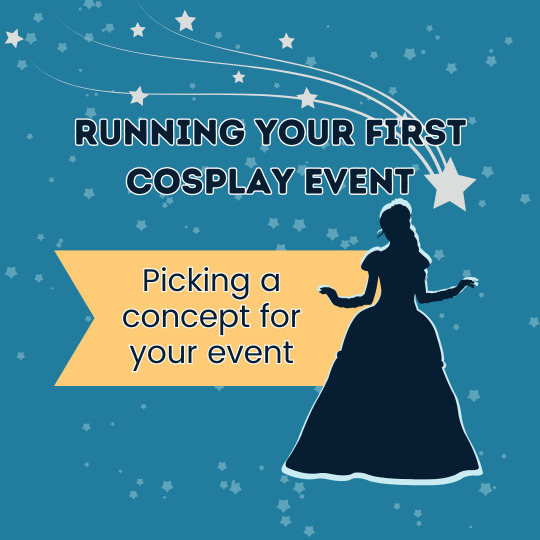
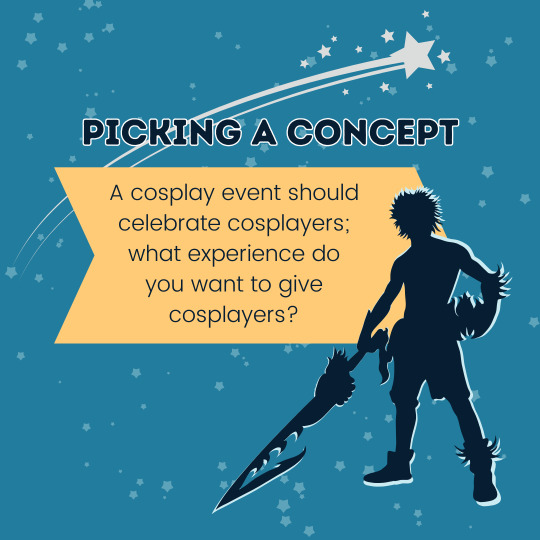
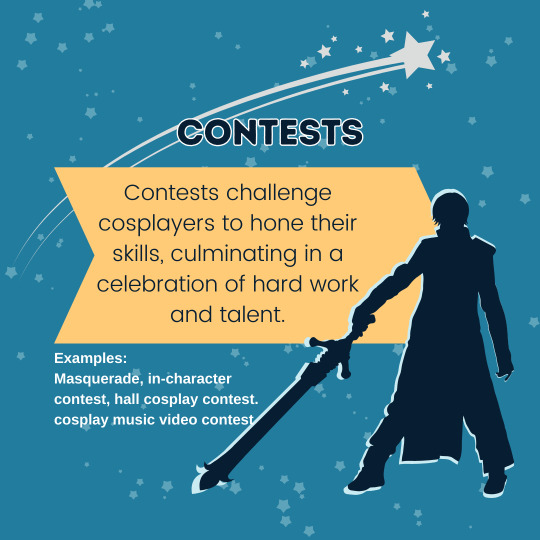
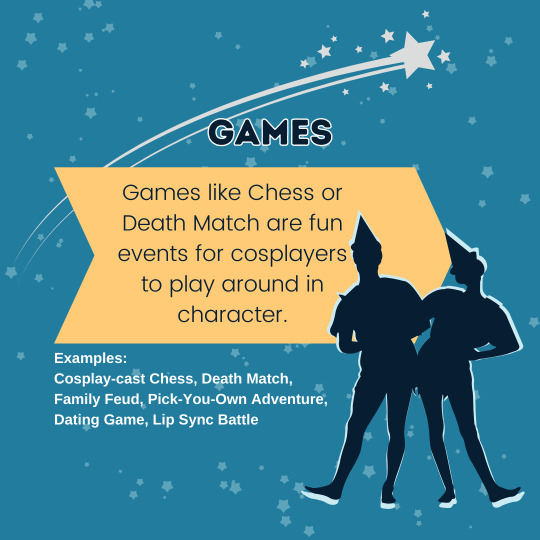

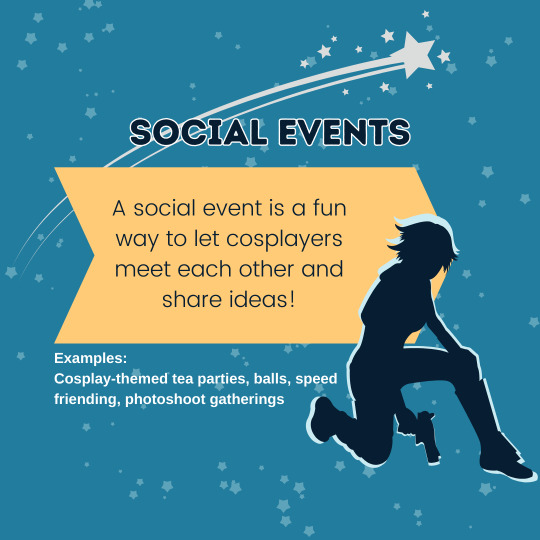

Cross-posted from Instagram: I've started to put together some notes on my experiences of running events!
7 notes
·
View notes
Text

a compilation of more of geheichou's (recent - as in Dec. 11 2024 to Jan. 3 2025) arcane cosplay posts from twitter~!

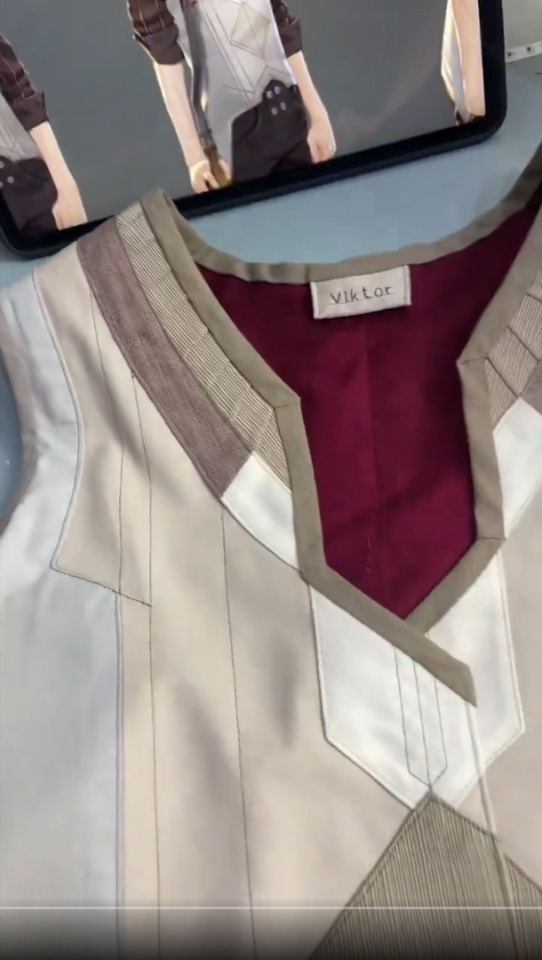

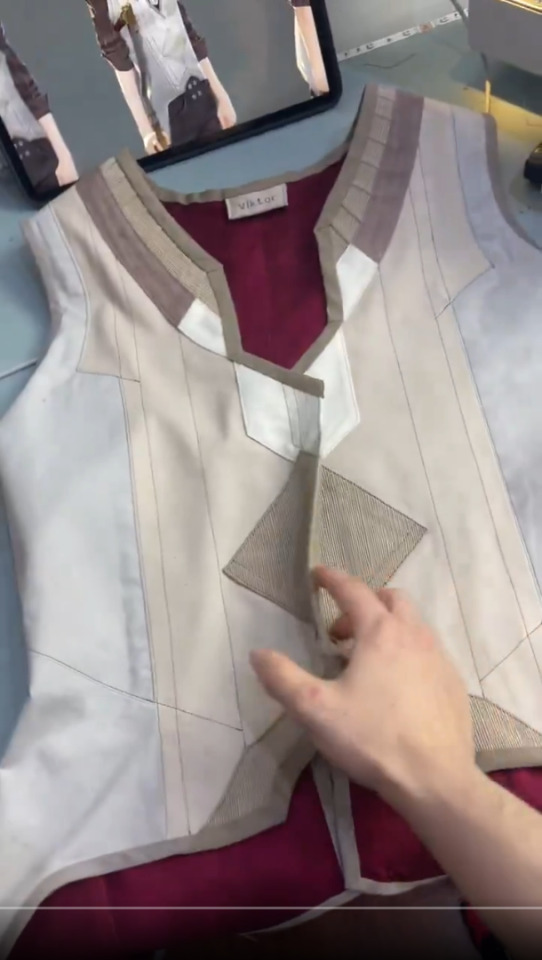

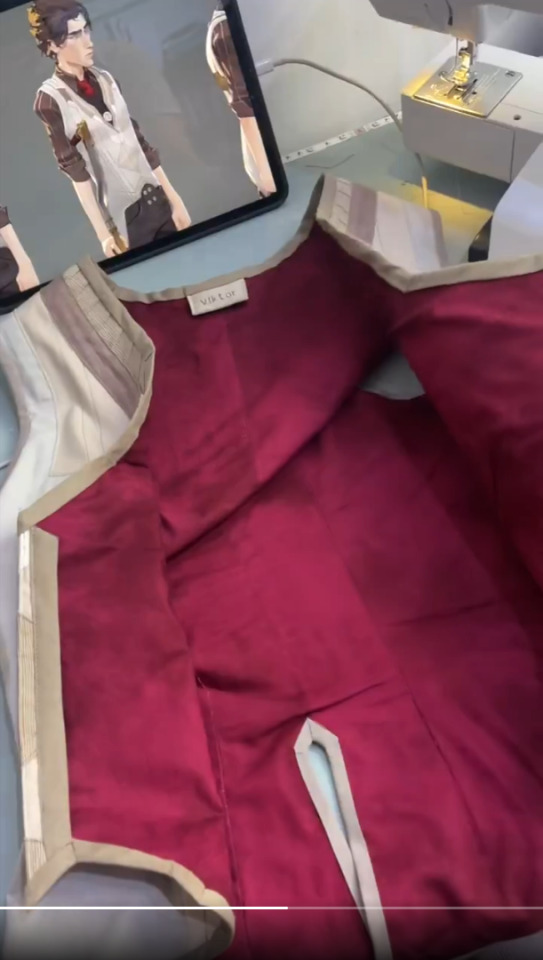
even Viktor's name on the tag! so cool!


the leg brace is so freaking cool. my guess is it's made of foam!

fanservice uwu even the messed up chalkboard, i love it!


all made of foam! i'm so grateful for the tutorial they shared as well
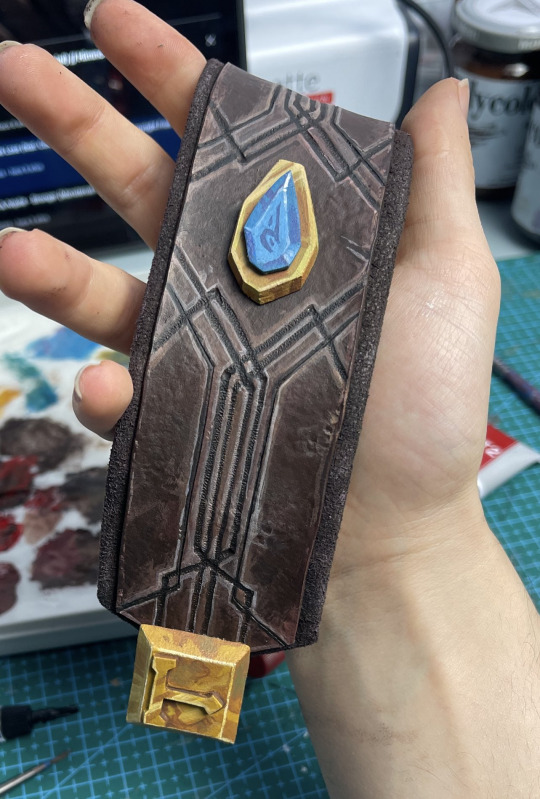

here's a direct link to the tiktok tutorial they posted for the jayce brace they made (copy and paste it if the link doesn't work because sometimes tumblr breaks tiktok links!) : https://www.tiktok.com/@geheichou/video/7452468594434198817

and finally their season 2 jayce makeup test from January 3rd 2025~

#geheichou#cosplayers are cool#arcane#arcane season 1#arcane season 2#arcane cosplay#viktor arcane cosplay#arcane viktor cosplay#arcane season 1 cosplay#arcane season 2 cosplay#jayce cosplay#jayce talis cosplay#jayce arcane cosplay#arcane jayce cosplay#cosmetics#long post#tiktok#tiktoks#cosplay inspo#cosplay inspiration
16 notes
·
View notes
Text
Prevent third-party sharing
This option will prevent your blog's content, even when reblogged, from being shared with our licensed network of content and research partners, including those that train AI models.
In the app:
Tap your account settings (the little human), and select the blog (if not already selected) in the top, left-hand corner of the screen.
Tap the gear icon, select "Visibility," and turn on the "Prevent third-party sharing for [your blog name]" switch.
On the web:
Visit your blog settings.
In the "Visibility" section, turn on the "Prevent third-party sharing for [your blog name]" switch.
If you've already chosen to discourage searching of your blog, we've automatically enabled the "Prevent third-party sharing" option.
---
CosplayTutorial has 3rd party sharing turned off.
Hi, Tumblr. It’s Tumblr. We’re working on some things that we want to share with you.
AI companies are acquiring content across the internet for a variety of purposes in all sorts of ways. There are currently very few regulations giving individuals control over how their content is used by AI platforms. Proposed regulations around the world, like the European Union’s AI Act, would give individuals more control over whether and how their content is utilized by this emerging technology. We support this right regardless of geographic location, so we’re releasing a toggle to opt out of sharing content from your public blogs with third parties, including AI platforms that use this content for model training. We’re also working with partners to ensure you have as much control as possible regarding what content is used.
Here are the important details:
We already discourage AI crawlers from gathering content from Tumblr and will continue to do so, save for those with which we partner.
We want to represent all of you on Tumblr and ensure that protections are in place for how your content is used. We are committed to making sure our partners respect those decisions.
To opt out of sharing your public blogs’ content with third parties, visit each of your public blogs’ blog settings via the web interface and toggle on the “Prevent third-party sharing” option.
For instructions on how to opt out using the latest version of the app, please visit this Help Center doc.
Please note: If you’ve already chosen to discourage search crawling of your blog in your settings, we’ve automatically enabled the “Prevent third-party sharing” option.
If you have concerns, please read through the Help Center doc linked above and contact us via Support if you still have questions.
95K notes
·
View notes
Note
If you're looking for resources to start cosplaying? Check out cosplaytutorial(dot)com/list(dot)php
it's a compilation of tutorials on how to make things, and they've got material guides too! You could probably read through some of those to boost your skills.
thank you so much! this is very helpful
0 notes
Text
Jack Frost Staff Tutorial - Part 1
This is my how-to for making a Jack Frost Staff from Dreamwork’s Rise of the Guardians. When finished, the staff should stand about 6-8″ taller than yourself.
This tutorial uses measurements for myself (I am about 5’2”). So you may have to adjust the staff height itself accordingly. Say for example, you are 6ft or taller, you may have to buy one 10ft pole and shorten it so that the total staff height is 6-8 inches taller than yourself.
I will explain this more when I talk about attaching the crook and the pole together. For adjustments to the crook measurements, add the same number to each measurements to make sure that it will keep its proper shape after the adjustment. This tutorial is done in two parts, the first part is the construction of the staff itself. The second is painting it to look like the version from the movie. My friend and I have two versions of the finished staff, the first is done by stringing the colors onto the staff after painting it a base brown color. The second is entirely paint. Both give it a neat look at the end so it is entirely your preference for which you prefer to do.
Good Luck and let me know if you have any questions or need help ^_^
Part 1 - Construction of the Staff
What you will need
2 pieces of PVC pipe (1 in diameter, 5 ft in length)
3 PVC pipe caps
3 PVC pipe joints (45˚ angle)
1 PVC pipe joint (90˚ angle)
Heavy-Duty Cutting tool

Step One
Take one of the two PVC pipes, this will become the crook of the staff. This is where the cutting tools come in handy. I used a Dremel, but a hand saw or circle saw work just as good. Use a marker to measure out two 6 inch pieces, one 4 inch piece, and one 3 inch piece. Mark them like I did so you can keep track of which piece is which.

Step Two
Follow closely, we are going to take the pieces and make them look like the image on the right. You will need the pieces you just cut, one of the caps, and the joint pieces.
Take piece A and place a cap on one of the ends like shown. On the other end of piece A you are going to place a 90˚ angle joint piece.
Take piece C and attach it to that 90˚ angle piece you just placed. Now place a 45˚ angle piece on the other end of C.
Take piece B and attach it to the 45˚ angle piece you just attached. Place another 45˚ angle piece on the other end.
Take piece D and attach it to the 45˚ angle piece you just attached. Place the final 45˚ angle piece on the other end of piece D.

At this point your crook should look like the image on the right. Flatten the crook against the ground so that it lays flat. Make sure all the pieces are attached tightly to one another and the joints are secured on there.
Step Three
Here is where you may have to adjust the height measurements of the staff depending on your own height. Take the second PVC pipe and attach it to the crook you just made. Place one of the two remaining caps on the bottom of the pole. The crook itself should measure about a foot in height. Since I am 5’2’’, I cut off 4 inches from the second PVC pipe pole so that the total height of the staff is about 5’8 (which is 6 inches above my own height). If you are 6 ft tall normally, cut the 10 ft pole to 5 feet, 6 inches, that way when you attach the crook (which is 1 ft) your total staff height is 6 feet 6 inches.
**If you have questions about this part, or unsure, feel free to send me a note in my inbox and I will help you out with the measurements. **

Step Four
For this part, you can do one of two things. You can simply attach the cap to the 45˚ joint connecting the staff and the crook, or you can cut a small 2 inch piece of pipe and place the cap on that to attach.
Start by gluing all of the joints down to each piece. Make sure the pieces are secure before gluing. This gives the staff some sturdiness.
Next, align the piece onto the joint so that its sits at a slight angle. You may want a second person to help you with this part. Have someone hold the piece in place which you place glue around the piece attaching it to the joint.
Don’t be stingy with the glue, give it a nice thick coat making sure it is firmly attached - you can always sand the extra away after it dries.
For added security, attach rubber-bands to hold the piece in place while the glue dries.
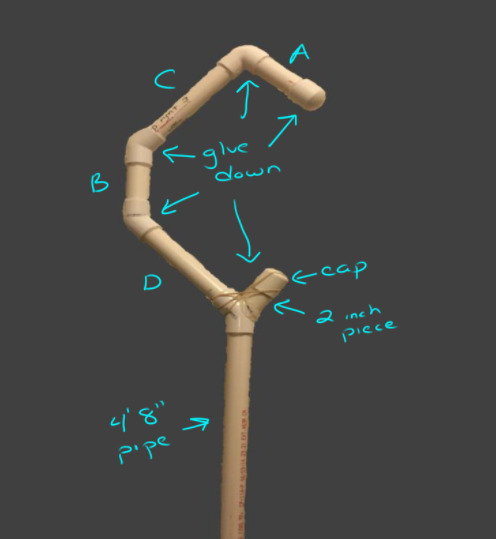

Congratulations!!
Now you have the base for your Jack Frost Staff. See Part 2 – Painting the Staff
#cosplaytutorial#cosplaytutorials#jackfrost#riseoftheguardians#dreamworks#cosplayer#cosplaying#cosplay#stafftutorial#propmaking#propmaker#jackfroststaff#jackfroststafftutorial#riseoftheguardianstutorial#guardian
19 notes
·
View notes
Photo

Learn my wing making secrets in my iridescent fairy wing tutorial that is now public, free for everyone to view! Swipe for the intro, my Instagram Stories will also take you there as will my bio menu 🌟 🧚♀️🌟 #fairywings #diyfairywings #cosplaytutorials #wingtutorial #fairwingstutorial #faerie #maker #iridescentwings #steampunkwings #faeriewings #fairyartist https://www.instagram.com/p/B0o7FDUlDjo/?igshid=1aikr8m741pgk
#fairywings#diyfairywings#cosplaytutorials#wingtutorial#fairwingstutorial#faerie#maker#iridescentwings#steampunkwings#faeriewings#fairyartist
41 notes
·
View notes
Text
Hello there!
My advice is to do some research beforehand, start with small things, and lean on your fellow crafters.
Reasearch beforehand:
There's a WEALTH of crafting information out there! Start with blogs like @cosplaytutorial that compile resources, and also find creators doing things you like. A lot of us post resources of things that we create, such as build threads, tutorials, videos, etc., that show our techniques. Don't expect to be perfect immediately, and obviously you have to do the task yourself, but getting information about what is out there is very helpful.
This also goes for looking for resources on something specific you want to make -- say, you want to make a sword, so you look for tutorials for similar swords. Learn sewing and crafting terminology (different types of seams, different types of skirts or sleeves, etc.) to give yourself a base to work off of when searching for information. You will have to learn how to adapt patterns and tutorials that aren't for your specific costume into something for your costume, and that is a skill in and of itself! Learn how to break down your costume into smaller components so you know what you are looking at. Which leads me to...
Start small:
You don't have to make an entire costume yourself in one go. You can start with buying pieces and modifying them, or with making just one piece and buying the rest, or even buying a whole cosplay and remaking parts of it or even just refitting it to your body. My first cosplay (way back in 2003) was a storebought tank top and skirt my mom helped me make, and I worked my way up from there.
For simple first sewing projects, rectangle skirts, bloomers, shorts, pleated skirts, basic darted bodices, etc. are perfect. Things with simple lines and not too many curves. Get a sewing pattern and look at it. Look at your own clothes and their seams and how they are put together. Take apart garments and put them back together if you feel brave.
You will need to get some practice in looking at garments to see how they go together and what the shapes are, but that skill will do you very well in seeing how a 2D garment (one that doesn't have things like seams drawn or that otherwise doesn't work like an irl 3D garment) can function in reality. Being able to break down a costume into smaller chunks makes it far less overwhelming and easier to see what you are looking at, as well.
No shame in following patterns and tutorials step by step, either! That's how you learn the base skills you need, which you can iterate on later.
Lean on other crafters:
I touched on this in the first point, but I'll say it again: there's a wealth of resources out there, and you can and should use them. A LOT of cosplayers these days make full patterns for popular costumes. Choose one you like that doesn't seem to difficult and make it. Even just part of it. Look at videos, text tutorials, anything youc an get your hands on.
Ask questions. Most cosplayers are more than happy to share our methods. It tends to be better to ask a specific question, like "what fabric would be good for this?" or "I'm thinking of doing these techniques, would that work? ow can I adapt this technique into this thing?" rather than asking about an entire costume. Join communities of crafters.
I also have this (somewhat outdated, but still hopefully helpful) panel slide deck that might help.
Hope all that helps! Good luck on your crafting journey :]
Hey, Cosplay people! I want to get into cosplay/making my own costumes and clothes! What resources should I look into to start learning or what advice could you give me?
Thanks! Love you guys 💞
40 notes
·
View notes
Photo

#protip - "When weathering and aging a prop or garment using sand paper, as well as washes of browns and greens and dusting the still-wet paint with ground up chalk or pastel is a great way to add a 'well loved' look to your items." - ❤️ 🐰 . . . . #bunni #snowbunnystudios #cosplay #costume #costuming #cosplaying #cosplayer #cosplayersofinstagram #rpf #replicapropforum #craftyourfandom #cosplayprop #cosplaywip #cosplaytutorials #cosplayhelp #propmakingtips #propsmaking #props #diy #howto #crafting #cosplayproblems #weatheringprops #weatheringcosplay #inspirationalquote #thingsbunnisays #bunnihelps #cosplaytips #sewingtips https://www.instagram.com/p/B3NiwaSD_Zw/?igshid=1nz5zfq5eazsp
#protip#bunni#snowbunnystudios#cosplay#costume#costuming#cosplaying#cosplayer#cosplayersofinstagram#rpf#replicapropforum#craftyourfandom#cosplayprop#cosplaywip#cosplaytutorials#cosplayhelp#propmakingtips#propsmaking#props#diy#howto#crafting#cosplayproblems#weatheringprops#weatheringcosplay#inspirationalquote#thingsbunnisays#bunnihelps#cosplaytips#sewingtips
2 notes
·
View notes
Photo

Hey everyone! - Did you miss us? - - We missed you! After a much needed mental health break we are coming back to our channel with new videos and a new ideology to go back to our roots and create what makes us happy. - - Some new video concepts include prop making tutorial/vlogs, costume making vlogs, make up tutorials, and wig styling videos in addition to our regularly scheduled con vlogs and skits. - - New fandoms you can expect to see on our channel include BNHA, Critical Role, Disney, and more. - - With this new surge in content you can also expect to see us more on here too! - - Thank you for following us and for your support! We are excited to get back to doing what we love 💕 - - - #thecosplayinitiative #cosplaygroup #cosplayyoutube #cosplayskit #cosplaytutorials #cosplayvlogs #convlog #cosplayinitiative #cosplay https://www.instagram.com/p/BtJJX28nK4L/?utm_source=ig_tumblr_share&igshid=1njpv5byxhayb
#thecosplayinitiative#cosplaygroup#cosplayyoutube#cosplayskit#cosplaytutorials#cosplayvlogs#convlog#cosplayinitiative#cosplay
1 note
·
View note
Text
Keith Jacket Tutorial
I made my Keith cosplay jacket, and I’ve had quite a few people ask about it, so I’ve complied this guide! It’s quite long, but hopefully it helps if you are going the DIY route! You can either see this guide on Google Docs (recommended) or under the cut!

If you like this guide and found it helpful, consider fueling my future cosplay efforts by buying me a ko-fi?
Materials List:
Marine Vinyl
Red - i think i bought a yard of this?
White - i had about a yard and a half of this and half quite a bit leftover. A yard would probably do.
Yellow - 6” cut (default width from Joann’s is 54” so this is plenty!)
Burgundy - 6” cut (see above)
Marine vinyl isn’t the most expensive cosplay fabric out there (*cough* Yaya) but it isn’t exactly cheap at $19.99/yard. I got lucky and found some big pieces in the remnants bin. It seems to rarely go on sale, so maybe save those 50% off coupons for this!
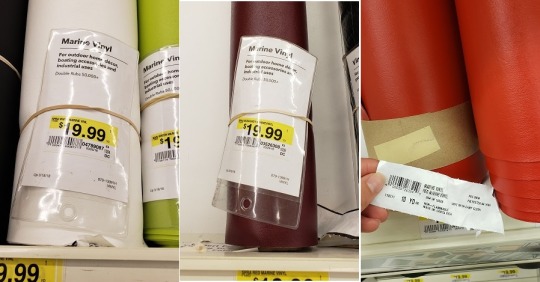
I DO NOT RECOMMEND YAYA’S 4-WAY PLEATHER. I bought some in red to use originally for the red portions for the stretchiness, and it BLED on my white vinyl while the materials sat waiting to be used, so i opted not to use it (and had to scrap that portion of vinyl). The stuff you want looks like this on the backside!
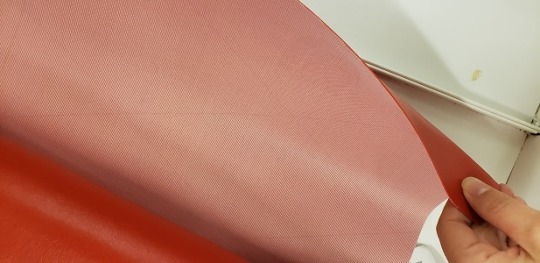
Needles
I used leather needles in my sewing machine, since i was using marine vinyl as a substitute for leather. They are specifically designed to cut through the heavier material. Mine were 90/14. You might want something even heavier. These would probably do just fine.
I used stretch knit needles for the jetset (see “lining”).
Thread
You will need white, red, yellow, and burgundy thread to match the vinyl. Either buy at the same store so you can check that it matches, or take a small sample snippet with you to make sure the colors match!
Zipper
I used a 12" sport separating zipper. These come in 2” increments, and I am on the tiny side (5’2”) so you might need a longer one if you are taller (or want a longer jacket)
Pattern
On the advice of CrescentShay (who is very talented and you should follow her if you aren’t already!) I based my jacket on McCall’s “totally not pokemon go trainer” pattern (M7556). You will also want either tissue paper (from your local dollar store), tracing paper, or medical pattern paper.
Lining
I used Red JetSet for my lining - i think i bought like 1.5 yards because it’s pretty cheap. It’s soft, colorfast, and fairly easy to work with. It also has some stretch and a nice flow to it. You can use whatever you’d like.
Mockup Fabric
I bought crazy cheap satin from walmart cuz it’s $2/yard. You can use muslin, old bedsheets, whatever you have handy, as long as it isn’t stretchy because THE JACKET WILL NOT BE so you want the mockup to have the same fit. DON’T. SKIP. THE. MOCKUP!
Tips and Notes:
Marine vinyl DOES NOT STRETCH. This guide is written based on the jacket I made as of its writing (Sept 2018) and thus is written based on NONSTRETCHY material. If you use a different material, be mindful of how that material works!
MEASURE EVERYTHING TWICE
Do not skip the mockup!
Pine & try it on frequently!
Watch your foot (of your sewing machine!)
Test stitches on scraps first! You want to make sure that tension and stitch sizes are what you want them to be!
Finished seams make it look professional
This portion will be broken down into several components:
Pattern and Mockup
Jacket base
Sleeves
Collar
Cuffs
Burgundy stripe
Lining and zipper
I will assume you, dear reader, have a base knowledge of sewing with a machine (like to sew inside out, how to thread the machine & adjust tension/stitch size, etc.) but you are welcome to DM me if anything is unclear or I have left out details! I am @corwynte on most social media.
Pattern and Mockup
If you have never used a pattern before, it is important to make sure you CHECK YOUR MEASUREMENTS. Pattern sizes are usually NOT standard sizes! I am a size 10 in patterns and a 0-6 in most clothing. So check your measurements! I used the “B” design for the pattern, because the jacket has a collar. This pattern is designed for sweatshirt type fabrics, not vinyl, so if you are not sure, GO UP A SIZE because again, VINYL. DOES. NOT. STRETCH.
I cut out my pattern pieces, but you might want to trace them instead. I trace my patterns now because then I can reuse them. Your call.
You will need pattern pieces 3, 4, 7, and 10. The band and cuffs are meant for stretchy material, so we’ll make our own patterns for those. You can also freehand the collar but I worked from the base of the hood.
With your tracing paper, add an extra 3” to the bottom of pieces 3 and 4.
Follow the instructions to cut out the vest and sleeves from your mockup fabric. Be mindful that many patterns have seam allowances, and for this pattern they are ⅝”. We are going to use this standard allowance.
My machine has marks on it, so I line up the edge of the fabric with these for my seams. If yours does not, you can mark them out with a marking pencil or a sharpie. It doesn’t matter if your mockup is a mess, we are going to draw on it later anyway. You do want to sew the seams properly though because NOW IS THE TIME to make sure the fit is correct.
**Save your patterns! We will use them for the lining too!**
You only need to attach the sleeves and pieces for the mockup - the rest of the sems don’t need finished. Once your mockup is complete, try it on! Make sure it fits the way you want it too. Don’t worry too much about the length - we’re can add a couple more inches to the bottom with the burgundy.
With help from a friend or with a dressform if you have one, trace out the lines for the different colors on your mockup.
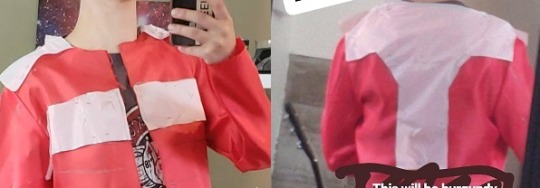
My white came out pretty big. You can adjust this to suit your own preferences, because this is an animated show so the size and shape of the jacket does vary slightly, and if you are basing your jacket on fanart rather than screenshots, different artists interpret the marks differently. Find what you like!
Once you are satisfied with the marks, either cut up your mockup for patterns, or trace the shapes with your pattern paper. I opted to trace, because my mockup was cheap satin which shreds easily and because I wanted to be able to reuse the mockup. For now we only need the chest portion of the vest - we’ll come back to the sleeves later, so don’t cut those apart just yet.
**Label your pattern pieces!** important things to include are:
Color the piece should be
What the piece is
How many to cut
Marks for where pieces will join together
Which side is which (side, front, top, etc.)
Jacket Base
If you are using vinyl, you can trace your patterns directly onto the backside of the vinyl with a light colored sharpie pen (mine was light pink). **ADD YOUR SEAM ALLOWANCES!!** You can eyeball these, since you will have the marks on the back of the vinyl to know where to stitch, but you should add ½ -⅝” seam allowance.
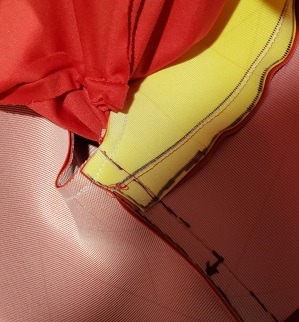
Cut out your pieces for the front and back of the jacket. Pin the “T” for the back of the jacket to a red pieces. You will need to notch the allowances to get it to lay right, but don’t jump into notching too quickly. Be careful with the T - you want to get it as symmetric as possible.
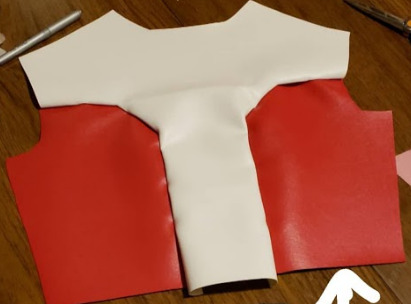
Once the back is done, pin the front too, then pin the front and back together and try the whole thing on!
It will fit slightly more loosely when the seams are done
The armholes might be tight (mine were) - we will adjust these later
Mostly we want to make sure it is lookin’ good, feelin’ good!
Sew the seams with a normal straight stitch first. Them we will fold over the excess and sew the seam again, lining up the seam with the edge of the foot and sewing a line in the color of the top material to give it a finished look. I did this to help my “T” lay flat and it really makes a huge difference in the look of the jacket - this will give it that “pro” touch!
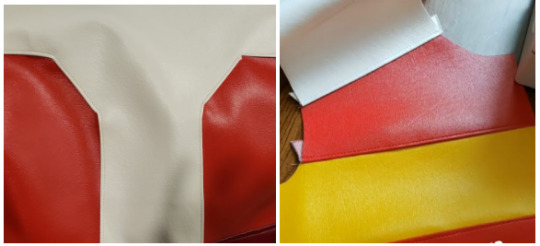
For the “T” - the white should be the “top” layer.
For the front stripes, white is the top over red, and both reds are top over yellow.
For the top seam, i sewed the back as top over the front.
Sew the sides together last. We will not fold over and double stitch that seam.
Now you’re done with the base! Pat yourself on the back!
Sleeves
Okay, now it gets harder from here.
A few notes before we start the sleeves:
Remember your seam allowances!
Vinyl does not stretch!
You can take extra fabric away, but you cannot (nicely) add more, so when in doubt, size up!
Measure the final width of the white on the shoulder of the jacket base. Good. Now measure it again. BE CAREFUL because matching these widths is really important to having the final product look clean and professional! (And remember your seam allowances!)
On your sleeve pattern, mark out the width of the white on the top of it and at the bottom of the sleeve (wrist). Use a straight edge to connect the lines. I made my white fairly wide, but again, suit your own preferences!
REMEMBER YOUR SEAM ALLOWANCES!
I made my sleeves MASSIVELY over-wide and trimmed them down a ton, because I was worried about not being able to bend my arms.
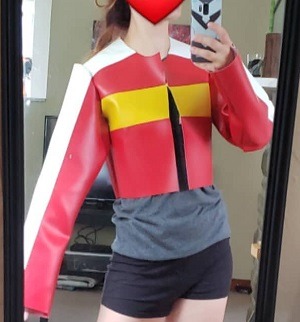
Test the size of your arm holes now, with your chest portion of the jacket complete. Widen them ass necessary so you can comfortably put on the jacket by cutting away from the BOTTOM portion of the arm hole.
Sew the white into the middle of the sleeves, again, being VERY CAREFUL to make sure the width matches up. Test it a bunch. Measure it a bunch. If you think you’ve measured enough, measure it one more time.
Finish the seams with white on top and a line of stitching.
Turn the sleeve inside out and sew the red pieces together. We will not fold over and double stitch this part either.
Turn the jacket base inside out and pin your sleeves to the base. Start at the top and MATCH UP THE WHITE. The excess should be at the bottom of the sleeve. You will probably have a bunch if you followed my advice. That’s fine.
Try it on again (Carefully! Pins!) Test the sleeves. Bend your arms, see how it feels. Get a sense of how much you want to take in the sleeves. Take it apart, take in the sleeves, pin it on again.
CAREFUL with the “pinches” that will develop from the sleeves (the bunching) - I was not careful with mine and they are not quite evenly pinched. You want these in the same spot.
Sew on your sleeves. Exhale. Be proud. The foundation of our jacket is now laid!
Collar
Okay, now we are going off the books. Remember pattern piece 10? The hood? We are going to base the collar on this because it is sized appropriately for our collar. Trace the pattern onto your pattern paper. Hold it up to your jacket. Tweak it, feel it out. Adjust as needed.
We are going to want a little extra for the hems, so BE MINDFUL of that as we proceed.
My collar is HUGE because aesthetic. You may want a smaller collar based on your own preferences, practicality for wearing, etc.
If you are using vinyl, you won’t need any interfacing because the vinyl is pretty stiff. If you are making your jacket from cotton, fleece, canvas, THE FORBIDDEN PLEATHER, etc. you will definitely need interfacing to stiffen it up.
I’m sure you know this by now but…
ADD YOUR SEAM ALLOWANCES
MEASURE IT TWICE

Cut FOUR pieces - be careful with mirroring these.
Sew the middle bits (back of neck) together first. Trim the excess (this is one of the ONLY times we will do this!) on this seam. Stitch the front edges and the top together. Leave the bottom open. Cut the corners diagonally so it can lay flat when you turn it right side out. Finish your seams with another line - be careful at the corners! Pin the collar to the neckline and check. It is okay if the neckline has a tiny bit extra at the front - we still need our zipper! If your collar is too big, take it in along that middle seam. Then, stitch your collar to the jacket.
Cuffs
Okay you know the drill by now. Allowances. Measure twice. Etc.
Measure around the bottom (wrist) of sleeve. Measure LOOSELY around the sleeve where you want the top of the cuff to be. Mine was 4½”.
Cut a pattern with the measurements that has a shape like the one shown. You’ll need 2 - one for each arm.
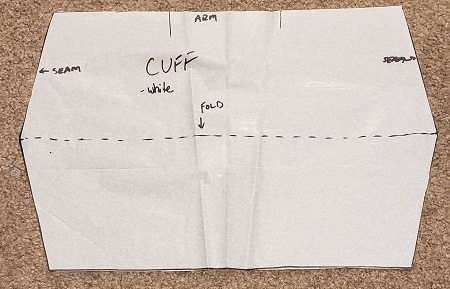
Fold the cuff in half with the “V” edges together - stitch these together.
Turn the cuff right side out and fold to make a tube. Stick the tube, top of cuff out, into the sleeve, and CAREFULLY stitch the cuff on. The fold the cuff up and over the sleeve. Make sure both sides are even!
Burgundy Stripe
Pine the burgundy vinyl to the base of the jacket and sew a seam. Fold it over, then finish the seam with the line of stitching. Easy peasy.
Lining
Use the patterns from your mockup to make a lining. I used red jetset, it is soft, it is colorfast, is has some give and is easy to work with. You can use whatever you like.
The only parts you will hem will be the bottom of the jacket and the bottom of the sleeves (near the wrist).
Sew the lining to the collar (right sides together) - this will finish this inner seam.
Stuff the arms into the sleeves. Pop your cuffs back down, then sew the lining into the sleeve (this is a tricky bit). The bottom we will leave open, so the last part to attach is the seams along the zipper.
Zipper
HOMESTRETCH!
Turn the jacket inside out. Open up the zipper and sandwich it in between the vinyl and lining. Sew the zipper on. Do the same on the other side.
Turn the jacket right side out and FINISH THOSE SEAMS! You will need your red, yellow, and burgundy thread for this. Use the appropriate color for the portion of jacket. My machine got real cranky on the burgundy cuz of the layers. I am going to tweak this guide with where you can trim excess to make this easier.
CrescentShay - her post helped me get started on my jacket! It was immensely helpful
My mom - she taught me how to sew, helped me make all my early cosplays, gave me her sewing machine, and always answers the phone when i call begging for tips and advice on a new project!
2 notes
·
View notes
Video
instagram
Venom 🕸️ #venom #venommovie #cosplaygirl #cosplaytutorials #nolamua
12 notes
·
View notes
Photo

I think because I posted a few bodypaint cosplays last week, I've gotten a handful of messages about bodypaint! If you are interested in tutorials, I have both cream paint and airbrush bodypaint tutorials available for FREE on my 100% free Patreon! www.patreon.com/AmazonMandy I fell behind on adding new tutorials after just moving but should be soon! #cosplaytutorial #tutorial #cosplaytutorials #bodypaint #bodypainttutorial #makeup #makeuptutorial #airbrush #airbrushtutorial #cosplaymakeup
#airbrushtutorial#bodypainttutorial#makeuptutorial#bodypaint#cosplaytutorials#airbrush#cosplaymakeup#tutorial#makeup#cosplaytutorial
15 notes
·
View notes
Photo

I am so very happy to announce a new group has been created where there has been a void for too long.. @sheprop! has been forged for female propmakers, costumers, sfx artists and more! Ladies, this is a space for us to gather, learn, show off, question, ask for advice, and post your WIP photos. . More information about this amazing (and quickly growing) group can be found on Facebook! I hope to see you all there, whether you are new to cosplay or have been doing this for decades, we would love you to join us! . #sheprop #propmaking #womenofpropmaking #womenofcosplay #femalemakers #strongwomen #artists #sfxartist #cosplayer #girlsofcosplay #cosplaytutorials #warriorwomen #helpinghand
#sheprop#sfxartist#propmaking#cosplaytutorials#helpinghand#warriorwomen#femalemakers#strongwomen#girlsofcosplay#artists#womenofcosplay#womenofpropmaking#cosplayer
5 notes
·
View notes
Text





Since I was so busy with con crunch I didn't really post progress photos from Jolyne and Jotaro, so I'll be starting to post some WIP breakdowns with useful tips and tricks I learned along the way! Buckle up for a long post below!
Here's an overview of the applique process for Jolyne. The main techniques I learned from a spandex applique tutorial by Spandex Simplified which you can find in my Linktree. I started by planning and drawing all of the applique designs on my sewing patterns, experimenting with a couple different scales of the grid and spiderweb design until I found something that looked proportionate to me and the artwork. This also allowed me to pre-plan for the pattern matching of the grid on the seams of the pants and top. Additionally, the top applique pattern is designed to hide the bust dart seams so it has a visually seamless appearance. The darts are curved rather than angular to avoid a pointed shape with the excess fabric cut away and stitched in a lapped seam style to reduce bulk.
After finalizing the applique patterns in paper, I used chalk tracing paper and a tracing wheel to transfer them to the white holographic spandex. Basically for each blue garment fabric piece, there was a corresponding white piece of the same shape that I then cut the applique designs out of. I couldn't get a rotary cutter to behave for cutting the applique designs out since the spandex was slippery, so I found it worked best to just cut the designs out with a sharp pair of fabric scissors.
Odif 505 temporary fabric spray adhesive is the BOMB. I just got it from my local Joann store, but if you can't get it the Spandex Simplified tutorial compares other adhesives you can try. Basically instead of using Heat-n-Bond like for regular applique, you spray the back of your spandex applique piece and then stick it onto your base fabric. Make sure to ventilate your workspace and wear a respirator, the fumes are not good! The Odif is temporary and can be repositioned, which I had to do quite a bit especially on the pants with a ruler to get all of the grid lines perfectly straight and positioned. You can always spray a little more on your piece and try again if it loses tackiness. I also had to go back and pin down all the areas that felt loose to prevent the design from shifting while sewing.
After your designs are temporarily glued on, use a small zizag machine stitch to stitch them on permanently. From a distance the zizag is nearly invisible, and more importantly it can stretch. I used Sulky rayon thread since the shine helped it vanish into the shiny spandex. The worst part of the applique process is doing trial and error tests to find the perfect machine tension and stitch size. I recommend cutting a sizable test version of one of your applique designs, and keep playing with machine settings until you end up with pucker free results. Then don't dare change your machine settings until you're done. I usually take pictures of my machine settings to document for later in case I need to remake something. The process is such a pain but so worth it!
This post is already way too long haha. I'll post some more stretch sewing tips I've learned in the future though since it's an entirely different beast from most stitching. Let me know if you have any questions!
#cosplay#costume#cosplaywip#cosplaytutorial#jojosbizarreadventure#jojocosplay#jolynecujoh#jolynecosplay#stoneocean#jojopart6#spandex#spandexapplique#stretchapplique#applique#stretchsewing
7 notes
·
View notes
Text
Cosplay Tutorial: Genshin Impact Dottore´s mask
Cosplay Tutorial: Genshin Impact Dottore´s mask
I return today with you a quick rundown on how you can easily make your own mask, and even provide you with a pattern and list of materials I used. As for the rest of the Cosplay, I honestly need to get out of the Cosplay burnout before I will make the rest of it, and this will take some time. Stay tuned for that! This tutorial is specifically for the “Omega Build” of Dottore, and not the…
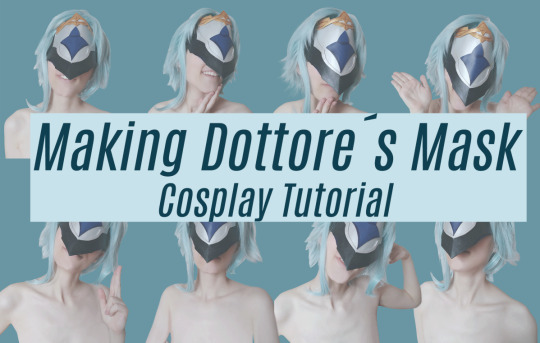
View On WordPress
5 notes
·
View notes